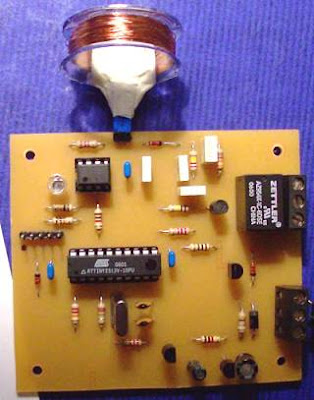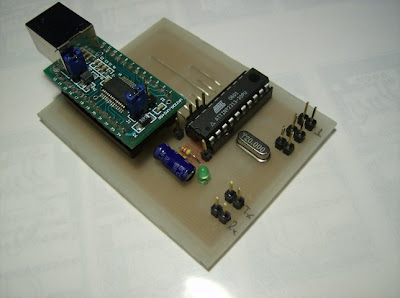Fish Robot Project
Principles of the Swimming Fish Robot
We can say that fish swim with pushing water away behind them, though fish swim by various methods. As the well-known categories for the swimming fish, a zoologist, C.M. Breder classified into the following three general categories based on length of a tail fin and strength of its oscillation (see the figure to the right).
(a) Anguilliform: Propulsion by a muscle wave in the body of the animal which progresses from head to tail like the Eel.(b) Carangiform: Oscillating a tail fin and a tail peduncle like the Salmon, Trout, Tuna and Swordfish.(c) Ostraciiform: Oscillating only a tail fin without moving the body like the Boxfish.






http://nereus.mech.ntua.gr/pdf_ps/med03.pdf
A simplified propulsive model of bio-mimetic robot fish
and its realization
SUMMARY
This paper presents a simplified kinematics propulsive model
for carangiform propulsion. The carangiform motion is
modeled as a serial N-joint oscillating mechanism that is
composed of two basic components: the streamlined fish
body represented by a planar spline curve and its lunate
caudal tail by an oscillating foil. The speed of fish’s straight
swimming is adjusted by modulating the joint’s oscillatory
frequency, and its orientation is tuned by different joint’s
deflections. The experimental results showed that the proposed
simplified propulsive model could be a viable candidate
for application in aquatic swimming vehicles.

Principles of the Swimming Fish Robot
We can say that fish swim with pushing water away behind them, though fish swim by various methods. As the well-known categories for the swimming fish, a zoologist, C.M. Breder classified into the following three general categories based on length of a tail fin and strength of its oscillation (see the figure to the right).
(a) Anguilliform: Propulsion by a muscle wave in the body of the animal which progresses from head to tail like the Eel.(b) Carangiform: Oscillating a tail fin and a tail peduncle like the Salmon, Trout, Tuna and Swordfish.(c) Ostraciiform: Oscillating only a tail fin without moving the body like the Boxfish.

http://www.nmri.go.jp/eng/khirata/fish/general/principle/index_e.html
Fish Robot (Analysis And Mathematical Modeling of Thunniform Motion)
This research, Institute of Field Robot (FIBO) use the yellow-fin prototype tuna to build the robot because of its movement ability in high speed for a long time, thunniform mode, which make us believe that its movement will be the most efficient locomotion mode than other aquatic mammals. Additional, the body profile is both symmetrical in horizontal and vertical plane, which is helpful for finding out the equation of motion.
Fish Robot (Analysis And Mathematical Modeling of Thunniform Motion)
This research, Institute of Field Robot (FIBO) use the yellow-fin prototype tuna to build the robot because of its movement ability in high speed for a long time, thunniform mode, which make us believe that its movement will be the most efficient locomotion mode than other aquatic mammals. Additional, the body profile is both symmetrical in horizontal and vertical plane, which is helpful for finding out the equation of motion.

http://fibo.kmutt.ac.th/eng/index.php?option=com_content&task=view&id=265
Model Fish Robot, PPF-06i
It was confirmed that the PPF-06i swims with swimming speed of about 0.1 m/s using the micro-computer. Also, it was confirmed that the PPF-06i turns with turning diameter of about 1 m, when the tail swings to one side during the turning. I think that one of the above purposes, (i) Swimming of the fish robot using R/C servomotors controled by a micro-computer, was achieved approximately.On the other side, another of the purposes, (ii) Simple control by Sensors , has not been achieved.
Model Fish Robot, PPF-06i
It was confirmed that the PPF-06i swims with swimming speed of about 0.1 m/s using the micro-computer. Also, it was confirmed that the PPF-06i turns with turning diameter of about 1 m, when the tail swings to one side during the turning. I think that one of the above purposes, (i) Swimming of the fish robot using R/C servomotors controled by a micro-computer, was achieved approximately.On the other side, another of the purposes, (ii) Simple control by Sensors , has not been achieved.

http://www.nmri.go.jp/eng/khirata/fish/model/ppf06i/ppf06ie.htm
Design Concept of the PPF-08i
The model fish robot named PPF-08i has been developed after considering the previous model fish robots, PPF-06i and PPF-07i. The design concept and purposes are as follows:(1) Simple structure(2) Small size(3) High turning performance (small turning diameter),(4) Controlled by a microcomputer,(5) A basic model of the group robots.
Design Concept of the PPF-08i
The model fish robot named PPF-08i has been developed after considering the previous model fish robots, PPF-06i and PPF-07i. The design concept and purposes are as follows:(1) Simple structure(2) Small size(3) High turning performance (small turning diameter),(4) Controlled by a microcomputer,(5) A basic model of the group robots.

http://www.nmri.go.jp/eng/khirata/fish/model/ppf08i/ppf08ie.htm
Prototype Fish Robot, PF-600
Prototype Fish Robot, PF-600

The figure to the right shows the structure of the PF-600. A battery, R/C receiver and two servos are located in the body. Two rods connect link mechanisms in the two tail peduncles (forward and tail peduncles), and finally the tail fin through rod seals. For sliding rod seals, slide bearings are used. Other parts that do need to move are sealed with "O" rings.
http://www.nmri.go.jp/eng/khirata/fish/experiment/pf600/pf600e.htm
Fish Robot Research
On the Design of an Autonomous Robot Fish
Abstract—A fish-like propulsion system seems to be an
interesting and efficient alternative to propellers in small
underwater vehicles. This paper presents the early design
stages of a small autonomous robotic vehicle driven by an
oscillating foil. It describes the preliminary dimensioning of
the vehicle and the selection and sizing of the necessary
actuators according to the project’s objectives and constraints.
Finally there is a description of the control system
implementation for the tail’s motion.
Fish swimming is classified as carangiform, anguiliform,
thunninform and ostraciform, depending on the percentage
of their body that contributes in thrust production through
undulatory motions. According to this observation, there
are three alternative ways to design a robot fish, see Fig.
http://www.nmri.go.jp/eng/khirata/fish/experiment/pf600/pf600e.htm
Fish Robot Research
On the Design of an Autonomous Robot Fish
Abstract—A fish-like propulsion system seems to be an
interesting and efficient alternative to propellers in small
underwater vehicles. This paper presents the early design
stages of a small autonomous robotic vehicle driven by an
oscillating foil. It describes the preliminary dimensioning of
the vehicle and the selection and sizing of the necessary
actuators according to the project’s objectives and constraints.
Finally there is a description of the control system
implementation for the tail’s motion.
Fish swimming is classified as carangiform, anguiliform,
thunninform and ostraciform, depending on the percentage
of their body that contributes in thrust production through
undulatory motions. According to this observation, there
are three alternative ways to design a robot fish, see Fig.

http://nereus.mech.ntua.gr/pdf_ps/med03.pdf
A simplified propulsive model of bio-mimetic robot fish
and its realization
SUMMARY
This paper presents a simplified kinematics propulsive model
for carangiform propulsion. The carangiform motion is
modeled as a serial N-joint oscillating mechanism that is
composed of two basic components: the streamlined fish
body represented by a planar spline curve and its lunate
caudal tail by an oscillating foil. The speed of fish’s straight
swimming is adjusted by modulating the joint’s oscillatory
frequency, and its orientation is tuned by different joint’s
deflections. The experimental results showed that the proposed
simplified propulsive model could be a viable candidate
for application in aquatic swimming vehicles.

Fig. 1. Physical model of fish swimming.
http://journals.cambridge.org/download.php?file=%2FROB%2FROB23_01%2FS0263574704000426a.pdf&code=b84242209ac7a0d01e3a1a9fe14560df
Body Construction of Fish Robot in Order
to Gain Optimal Thrust Speed
Abstract
In fish robot, hydrodynamic shape of its body determines
the ability of the robot to swim. However, sometimes the
swimming gait depends not only on the body, but also on
the frequency of tail undulation and body angle when it
attempts to achieve fast swimming. Thrust speed becomes
the main objective in this research. Some variables which
are suspected as important variables influencing the thrust
speed were observed such as body shape, fin, frequency
of tail, and acceleration of tail. Results of investigation
show that there are some significant dependency among
thrust speed, frequency of tail undulation and body shape.
In some conditions it was found that there was some
optimal condition for all parameters which pace the fish
robot towards fastest thrust speed.
http://journals.cambridge.org/download.php?file=%2FROB%2FROB23_01%2FS0263574704000426a.pdf&code=b84242209ac7a0d01e3a1a9fe14560df
Body Construction of Fish Robot in Order
to Gain Optimal Thrust Speed
Abstract
In fish robot, hydrodynamic shape of its body determines
the ability of the robot to swim. However, sometimes the
swimming gait depends not only on the body, but also on
the frequency of tail undulation and body angle when it
attempts to achieve fast swimming. Thrust speed becomes
the main objective in this research. Some variables which
are suspected as important variables influencing the thrust
speed were observed such as body shape, fin, frequency
of tail, and acceleration of tail. Results of investigation
show that there are some significant dependency among
thrust speed, frequency of tail undulation and body shape.
In some conditions it was found that there was some
optimal condition for all parameters which pace the fish
robot towards fastest thrust speed.













